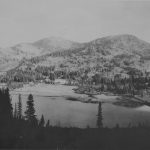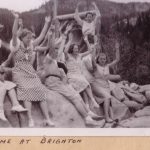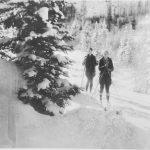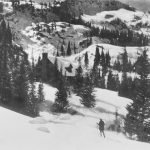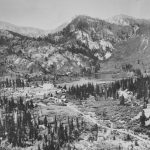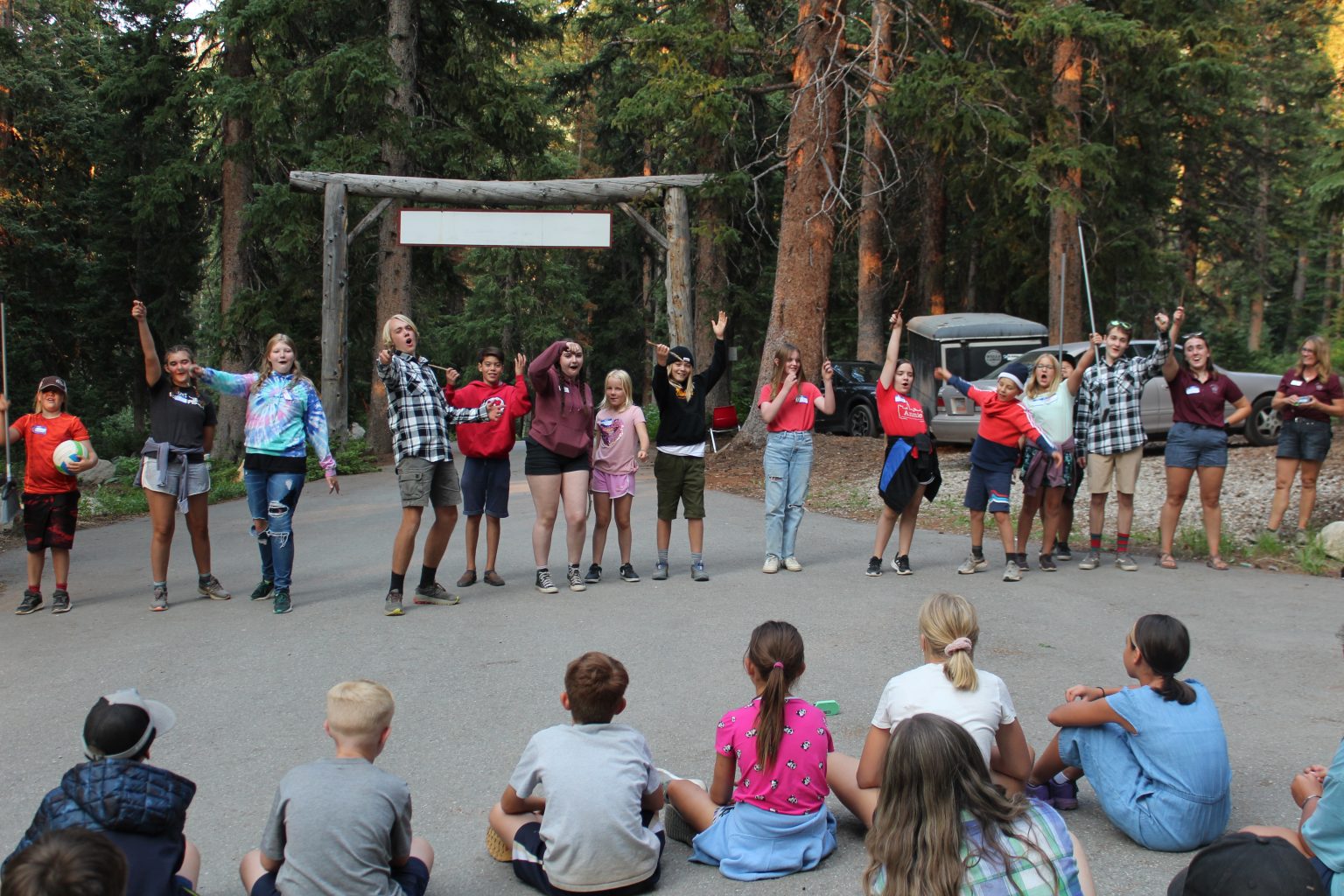
Tuttle's Story
Episcopalians and Brighton
Brighton, Utah is located at the top of Big Cottonwood Canyon, about 30 miles above Salt Lake City, and is a beautiful glacial bowl of glassy lakes and pebble-bottomed streams, teeming with broad-beamed virgin timber and fields of incredibly lush wildflowers.
Brighton was one of the favorite recreation areas used by Brigham Young and the Mormon settlers. In fact, it was on the 10th anniversary of their coming to Salt Lake that news came to Brigham Young as he was gathered with his followers in Brighton that Johnson’s Federal Army was coming to annihilate them. The records report some 2500 people gathered in Brighton on that July 24th, 1857.
In 1870, William S. Brighton and Joseph Elder stood at the top of the canyon and drew lots to see which areas they would prospect for silver. Brighton drew the Big Cottonwood site, and Elder the Little Cottonwood Canyon area where Alta is today. Eventually Elder gave up prospecting. The Brightons moved to the top of the canyon and lived in a one-room cabin. Several of his claims were “jumped” in 1880 when he was called to serve an LDS Church mission to Scotland. Brighton had made little money from mining, and at the time of his death, sold the property to the Jesse Knight Company.
Alta and Park City – one on either side of Brighton – were developed as mining boom towns, and so prospectors, salesmen and government men traveled to and from on foot and horseback, using Brighton as a “stop over.” Since William Brighton had not made his fortune in mining, Mrs. Brighton made a fair living by providing meals and lodging for travelers. Hence, the Brighton hotel was built. It was a “board and batten” two-story structure with seven bedrooms, a dining/sitting room, and a lean-to kitchen. Cabins were eventually added, each having a box stove and kerosene lamp. The hotel was situated near the present Village Store and Post Office.
A lake near the Hotel was named Silver Lake by Mrs. Brighton because of its shimmering appearance. A pier was built, and boats and rafts began to appear. Mrs. Brighton became known as the “fishing hostess.”
Each lake in the canyon has a story behind it. Lake Mary, at the top of the Mary chair lift, was named by artist, Borneman, after his wife. Lakes Phoebe and Martha were named by Bishop John Shoup and Mrs. Brighton. Martha is deep and has an island of black rocks. Lake Catherine was named after one of the Brightons. The Brightons stocked Lake Catherine with Mackinaw fish.
Eventually, other families moved into the area: a saw mill owner, a judge, and eight other families joined the Brightons. In 1894, another Brighton Hotel was built next to the old one. Brighton became a favorite summer recreation area to many Salt Lake families – those who were brave enough to use the rough road which followed the creek bed up the canyon.
The Brightons died in 1894, and the hotel complex eventually burned down. Brighton’s son, Robert, sold off most of the property. It was shortly after this, in about 1900, that Miss Theresa Godbe, a prominent Episcopalian who had been educated at the original St. Mark’s Grammar School, established a Girl’s Friendly Society Camp on land just below Brighton, which she leased from a Park City mining company for 99 years. A log lodge and several small cabins soon occupied this site. The summer camp for Episcopalian girls flourished until the depression when it was abandoned and ultimately deteriorated.
In the late 1940’s and early 1950’s, summer camping was done by the Episcopal Church in Ogden Canyon, and then at the Wasatch Mountain Club Lodge – at the top of Brighton’s “circle” near the M.I.A. Lodge.
Around 1951 or 1952, some young people of the Diocese were hiking through the area of our present camp, and discovered the ruins of a log lodge and several smaller cabins. They were interested in the origin of the ruins, and on checking around found that it was the remains of the old Girl’s Friendly Camp. They further discovered that the property had been leased to the G.F.S. by the Park City Mining Company on a 99-year lease. This discovery moved the young people to approach Bishop Watson on the possibility of renewing the lease and building a Diocesan Camp. Bishop Richard Watson responded with great interest, and rebuilding began. In the course of things, the mining company offered to sell the
property rather than lease it. The company sold all but mineral rights to the church for the fantastic sum of $1.00! The property so acquired had been called “the lady of the hill claim” by the Park City Mining Company. It now became known as “Camp Tuttle” in honor of the first bishop of Utah, Daniel S. Tuttle.
In addition to many gifts of labor and materials from within the Diocese, the Church received two large grants of money from the United Thank Offering of the Women of the Church. These funds were used to complete cabins and for building the lodge. In addition, memorial gifts were given for John Landenberger Jr., one of the young people who had been involved in the re-discovery of the property, and who had been killed by lightning in Idaho. These funds made it possible to build the beautiful Chapel of Christ the King.
The Episcopal Church has been using its present property for camps and conferences since 1958. Since that time, the addition of an A-frame cabin donated by a congregation once existent at Dugway, a shower house built by a diocesan fund drive, and a cabin built near the chapel and donated by St. Mark’s Cathedral were the only major additions to camp for over 20 years. Maintenance was carried on when money and manpower were available, but on no systematic basis. In 1981, a small grant of money was made available from Venture in Mission funds, and this money was intended to be used to upgrade the sanitary facilities.
In the late 1990’s, as interest in the beautification and modernization of Camp Tuttle had been growing, plans were made and carried out to build several new buildings, including a shower house and staff lounge with flushing toilets, a clergy cabin, an outdoor pavilion, and a basketball court. Renovations were made on the kitchen in the lodge, adding more bathrooms, and a deck. Each of the cabins was restored, some being completely rebuilt, and one being removed. An outdoor chapel was constructed while the chapel of Christ the King was insulated and got some new lights.
Episcopalians have been intricately involved in the history of Brighton since the turn of the century, and the little piece of property known as “Camp Tuttle” holds a dear place in the hearts of many Episcopalians, as well as the numerous other denominations that visit this awesome, spiritual place.
The Chapel of Christ the King, Camp Tuttle
This picturesque chapel was built in memory of John C. Landenberger, Jr. The building was designed by a student at the University of Utah as his master’s thesis project, and was constructed by the Weyher Construction Company of SLC.
The Christus Rex hanging at the east end of the chapel was executed by Angelo Caravaglia, a sculptor on the faculty of the University of Utah. This same artist later designed the present altar, candlesticks, lectern, and pews in keeping with the style and feeling of the Christus. Other ecclesiastical works by Mr. Caravaglia may be seen in Rowland Hall – St. Mark’s School Chapel, and at St. Mary’s Church in Provo.
Gallery

